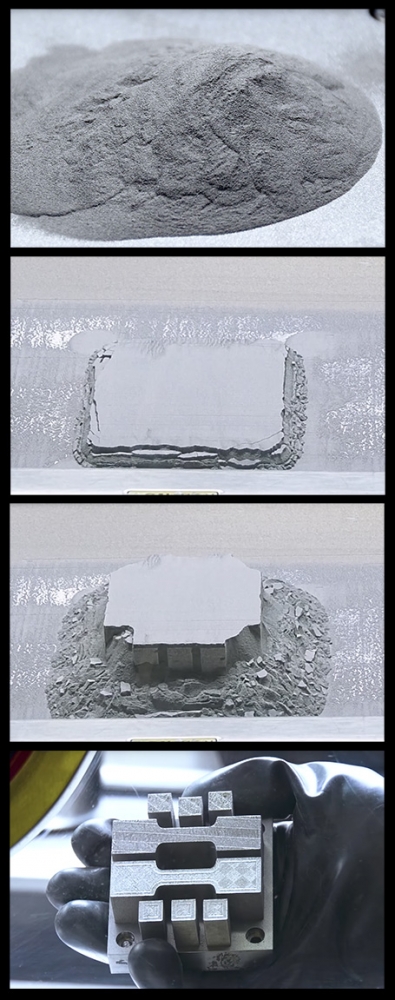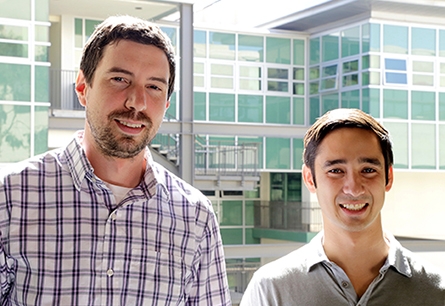High-strength alloys have been critical in the development of aircraft wings and fuselages, and other high-performance applications in demanding environments where margins for error are extremely small. Many alloys could also be useful in additive manufacturing, or 3D printing, which, at the highest level, makes it possible to fabricate complex, high-precision objects without the cost or geometric constraints of die-making and machining processes.
A few years ago, scientists at HRL, a research-and-development laboratory owned by The Boeing Company and General Motors, identified additive manufacturing as a technology that might provide a competitive advantage in the metallurgy space. But a decades-old hurdle stood in the way, which was, that of the roughly five thousand currently available alloys, only about ten could be used in 3D laser printing. That’s because, during the intense heating and ensuing cooling (solidification), the alloys experience something called “hot cracking,” which critically weakens the metal, to the point where it can be pulled apart like a flaky biscuit, according to HRL.
In addressing the problem, the HRL researchers identified “nanofunctionalization” as a possible solution to the hot-cracking problem. One member of the HRL team is John H. (Hunter) Martin, a fourth-year engineering PhD student working in the lab of CoE Alcoa Distinguished Professor of Materials Tresa Pollock. He enrolled at UCSB as part of an HRL program that allows its scientists to pursue a PhD while remaining employed at the company.
“I came to UCSB to work with Professor Pollock, one of world’s top metallurgists, so I could improve my understanding and grasp of the technology under development,” said Martin; he co-led the HRL group with Brennan Yahata, who will also be coming to UCSB as a PhD student in Pollock’s lab. “Our group at HRL realized the advantages of applying the nanofunctionalization process to additive manufacturing, but I personally, wanted to delve deeply into the metallurgical theory behind it in way that getting a PhD would allow.”
Now the HRL team has achieved a breakthrough by developing a technique for eliminating hot cracking, opening the door to using high-strength aluminum alloys and a wide range of other engineering-relevant alloys for 3D printing. The findings appeared as a Research Letter in the September 21, 2017 issue of the journal NATURE.
“We’re using seventy-year-old nucleation theory to solve a hundred-year-old problem with a twenty-first-century machine,” Martin said.
When unweldable high-strength aluminum alloys — those that cannot be joined using welds of the same material — are used in additive manufacturing, the resulting parts suffer severe hot cracking. HRL’s nanoparticle functionalization technique solves that problem by decorating such alloy powders with specially selected nanoparticles. The nanoparticle-functionalized powder is fed into a 3D printer, which layers the powder and laser-fuses each layer to construct a three-dimensional object. During melting and solidification, the nanoparticles act as nucleation sites for the alloy’s desired crystal microstructure, preventing hot cracking and allowing the alloy to retain its full strength in the manufactured part.
Because the melting and solidification processes in additive manufacturing are analogous to welding, the nanoparticle functionalization process, which is scalable and employs low-cost materials, can also be used to make unweldable alloys weldable.
“Our first goal was figuring out how to eliminate the hot cracking altogether. We sought to control microstructure and wanted a solution that happens naturally as part of how the material solidifies,” Martin said.

Above, from top: nanofunctionalized alloy powder ready for 3D printing; two frames showing progression of cumulative manufacturing of a solid alloy part as successive layers of laser-heated alloy powder harden and bond with each other; a finished 3D-printed object. Photographs courtesy of HRL Laboratories, LLC
The HRL team was assisted by Citrine Informatics, which used big data to help them sort through the myriad possibilities to identify the particular zirconium-based nanoparticles that had the necessary properties.
“Using informatics was key,” said Brennan Yahata, another HRL scientist and co-lead on the team, who is pursuing a PhD in Pollock's lab . “Metallurgy used to be done by farming the periodic table for alloying elements and testing, mostly by trial and error.” But by using informatics software, he added, “Once we told them what to look for, their big-data analysis narrowed the field of available materials from hundreds of thousands to a select few. We went from a haystack to a handful of possible needles.”
The result is another in a long line of successful outcomes resulting from partnerships linking UCSB College of Engineering researchers and industry.
“As a student in Professor Pollock’s lab, I could discuss findings with some of the top metallurgists in the country while having access to the resources, equipment, and training that both UCSB and HRL brought to bear,” Martin said. “At HRL, we made the material and operated the 3D printer used in the study. I was also able to leverage Professor Pollock’s advice, guidance and characterization capabilities to better understand the results and the fundamental metallurgy of the materials produced at HRL.”
Pollock, who recently received a prestigious 2017 Vannevar Bush Faculty Fellowship from the U.S. Department of Defense for research on 3D printed materials for use in extreme environments, said, “It is a privilege to mentor such highly motivated graduate students, who have clever ideas grounded in the fundamentals of materials science. Our collaborations with industry, in this case HRL and Citrine, greatly enhance and expand the impact of our materials research and provide unique research experiences for PhD students.”
There are the obvious benefits of enabling new high-strength aluminum alloys for additive manufacturing,” Martin said. “But the general concept of using nanofunctionalization to control solidification in in the process can be expanded so that new alloys from a variety of different compositions, including titanium-, nickel-, and iron-based alloys, can be used.”

HRL scientists and PhD students in Professor Tresa Pollock's lab (from left), John H. Martin and Brennan Yahata

